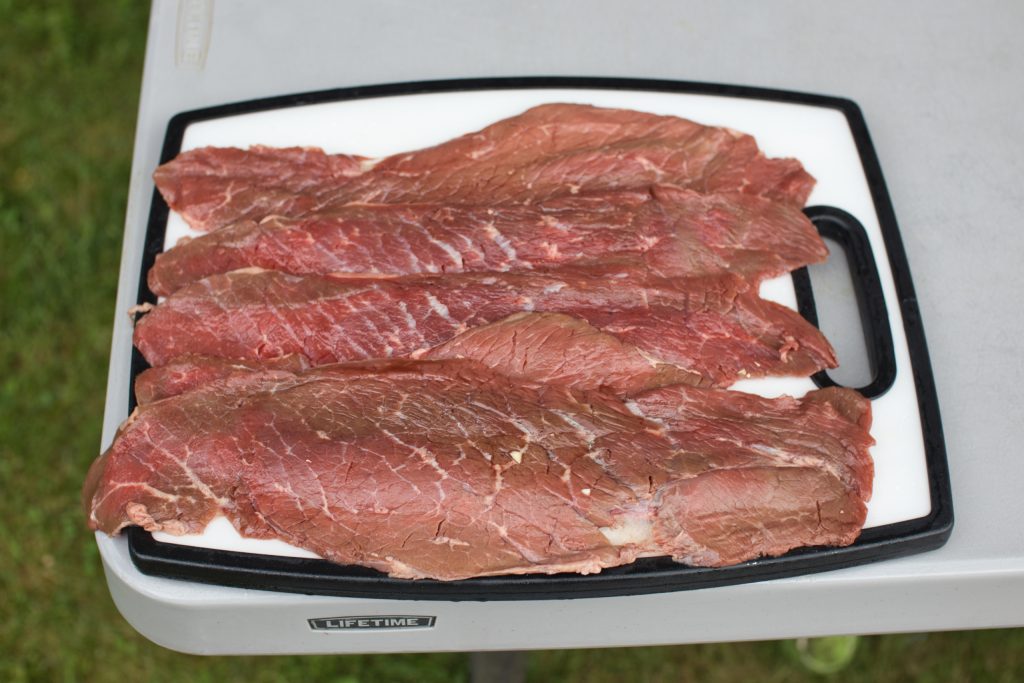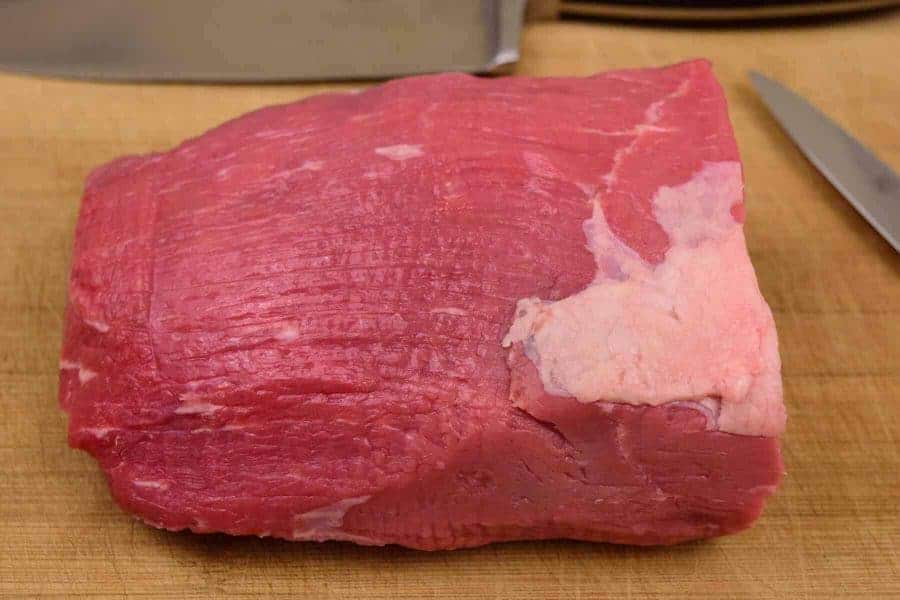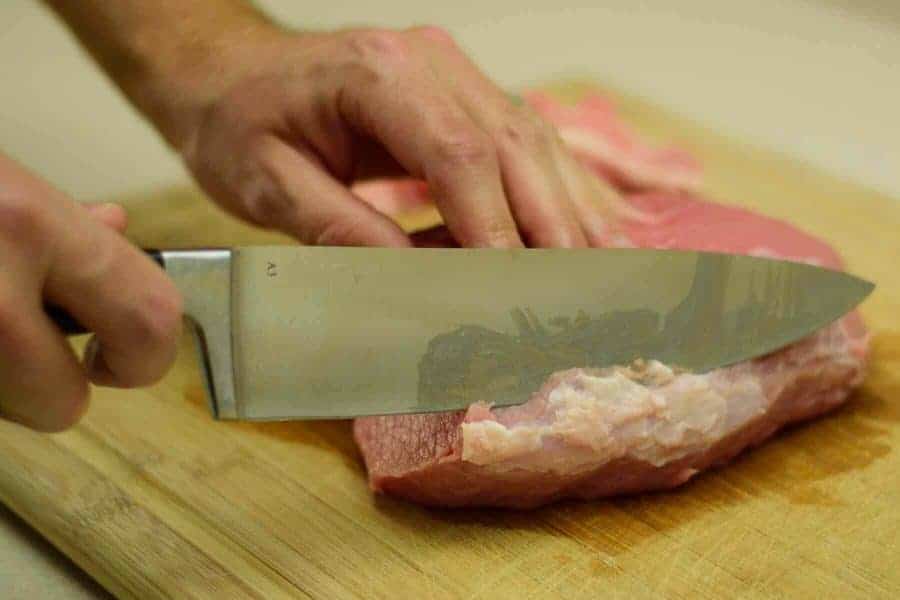Slicing beef is one of the most important steps when making beef jerky. How you slice the meat will determine the texture – soft and tender or tough and chewy In this comprehensive guide, we’ll cover everything you need to know about slicing beef to make the perfect jerky.
Why Slicing Matters
The way you slice beef when making jerky directly impacts the finished texture. Slicing with the grain produces a chewy, tougher jerky, while slicing against the grain makes a more tender jerky that’s easier to tear and chew.
Most people prefer a balance – slightly chewy but not too tough. Finding that sweet spot requires understanding grain direction and experimenting with different slicing techniques
Identifying Grain Direction
The “grain” refers to the direction that the muscle fibers run in a cut of meat. You can identify the grain by looking closely at the meat – the fibers will appear as thin lines running parallel to each other.
Beef cut with grain arrows
In the photo above, you can see the grain fibers running vertically from the bottom to the top of the meat.
Slicing With the Grain
Slicing “with” the grain means cutting slices parallel to the direction of the muscle fibers.
As seen in the image below, these slices follow the same direction as the grain lines:
Slicing with the grain produces a chewy, tough jerky that takes longer to chew. For some jerky fans, this texture is ideal.
Slicing Against the Grain
To make a more tender, easily tearable jerky, slice perpendicular to the grain direction. This is called slicing “against” the grain:
The slices cut against the grain break up the muscle fibers, as you can see in this photo:
Jerky made by slicing against the grain will be easier to tear and chew. The texture will be less tough.
Finding the Right Balance
For most people, the ideal jerky texture lies somewhere between the two extremes of slicing with and against the grain.
Here are some tips to hit the perfect balance:
-
Slice with the grain, then tenderize – Pound the meat with a meat mallet to break up the fibers after slicing. This makes it less tough than just slicing with the grain.
-
Try an alternating technique – Cut some slices with and some against the grain for batches with varied texture.
-
Slice on a bias – Cut diagonally across the grain instead of perfectly perpendicular. This moderates the tenderness.
-
Cut thicker slices – Thinner slices become tougher when dried, so try 1/4 inch cuts.
Experiment to find your own preferred chewiness level. It may take a few batches, but you’ll dial in that sweet spot.
Using a Jerky Slicer
While you can slice jerky meat with an ordinary knife, using a jerky slicer tool makes the job much easier.
These manual or electric slicers securely hold the meat and shave off thin, uniform slices in seconds. The results are faster, safer, and more consistent than hand slicing.
Quality jerky slicers like the Weston Pro-Series deliver perfect slices around 1/4 inch thick. This eliminates the need to trim strips to match sizes.
Slicing Tips
Follow these tips when slicing meat for jerky:
-
Trim off excess fat, which can cause spoilage
-
Chill the meat slightly before slicing to firm it up
-
Use a sharp knife or electric slicer for clean cuts
-
Keep slices uniform in size to ensure even drying
-
Work safely by securing meat and using proper knife skills
-
Slice with the chewiness texture you prefer in mind
-
Cut across any large grains that form when slicing against the grain
Key Takeaways
-
Slicing with the grain makes a chewy jerky, against makes it tender
-
Try tenderizing or slicing on a bias to hit an ideal texture
-
Use a jerky slicer for fast, consistent, uniform slices
-
Keep slices around 1/4 inch thick and be safety conscious
-
Experiment to find your perfect level of jerky chewiness
Careful slicing is crucial for great texture when making beef jerky at home. Follow these grain direction tips and techniques for your best jerky yet.

Video – Slicing meat
First, trim any visible fat from your cut of meat. Here is a lean Beef Eye of Round Roast before trimmed.

Use a sharp knife to cut away any fat. Fat makes beef jerky spoil faster, so it is best to trim as much as you can now to prevent your jerky from going bad.

Step #1 – Chill Your Meat in the Freezer
Before you even pick up a knife, the first step is to chill the meat to make it easier to handle.
Cover with plastic wrap and place your meat in the freezer until its firm, but not frozen.
Anything less than almost-frozen or very cold meat can be difficult to slice. Room temperature meat is wobbly, wiggly, and unwieldy. A firm, cold piece of meat is easier to slice, especially when you’re aiming for thin, even slices.
You shouldn’t actually freeze the meat. The meat should stay in the freezer until just chilled and firmed. The time will depend on the temperature of the meat and freezer. Check the meat after 30 minutes. It’s not unusual to leave it in the freezer for upwards of an hour depending on your starting temperature.
Take advantage of the chilling time to prep all your ingredients and equipment.
How to Slice Meat for Delicious Beef Jerky. Tips from a Pro.
FAQ
Should you cut beef jerky with or against the grain?
-
People’s Choice Beef Jerkyhttps://peopleschoicebeefjerky.comHow to Slice Meat for Jerky [5 Steps with Photos]Jan 30, 2023 — How do you like your jerky? Tough and chewy or soft and fall-part? Cutting with the grain yields a jerky with a tougher, more traditional chew. Cutt…
How to cut meat for jerky without a slicer?
I just lightly freeze it and slice it with a knife to my desired thickness. I end up with a little variation, but it’s mostly uniform. If you cut by hand and you’re making a lot, I recommend wearing gloves. Edit: even with the few pieces that come out too thin/thick, I just remove them from my oven earlier/later.
Should I freeze meat before slicing for jerky?
Step #1 – Chill Your Meat in the Freezer – Anything less than almost-frozen or very cold meat can be difficult to slice. Room temperature meat is wobbly, wiggly, and unwieldy. A firm, cold piece of meat is easier to slice, especially when you’re aiming for thin, even slices.Jan 30, 2023
Do you cut beef with or against the grain?
-
Shortening Muscle Fibers:Cutting against the grain shortens the muscle fibers, making the meat more tender and easier to chew.
-
Easier to Chew:By shortening the muscle fibers, you’re essentially doing a lot of the work for your teeth, resulting in a more pleasant eating experience.
-
More Noticeable with Tougher Cuts:The grain is more clearly defined in tougher cuts like flank, skirt, and hanger steaks, making it easier to identify and cut against.
How to slice meat for beef jerky?
How to Slice Meat for Beef Jerky: How-to Guide (with Pictures!) The general advice for slicing meat for beef jerky is to slice against the grain and to keep the meat thin at around 1/8 to 1/4″ thick. This thickness will allow the meat to dehydrate in 3-5 hours and cutting against the grain will offer a more tender texture.
What is beef jerky sliced against the grain?
A piece of meat sliced with the grain. Slicing against the grain yields a less chewy, softer jerky that loses slightly more moisture in the shorter muscle fibers than jerky cut with the grain. A piece of meat sliced against the grain. Slicing the meat for beef jerky. Now it’s time to slice the meat into the final strips.
How do you make the perfect beef jerky?
Crafting the perfect beef jerky demands meticulous attention to detail, starting with the precise cutting of the meat. The thickness, shape, and uniformity of the slices significantly impact the jerky’s texture, flavor, and drying time.
How do you slice jerky?
In the picture below, the fibers are running vertically from bottom to top. Slicing in the SAME direction of the fibers is called “slicing WITH the grain”. The 3 slices of meat seen above were sliced WITH the grain at about a ¼” thick. As mentioned earlier, slicing with the grain will produce a more chewy / tougher piece of jerky.
How do you make jerky easier to eat?
Alternatively, if you’d prefer jerky that’s in between the two extremes, you can slice your beef with the grain, then tenderize it with a meat mallet. Use the pointed side of the mallet to break up the muscle fibers and make the jerky a little easier to chew. 5. Consider Using a Jerky Slicer
Should you cut jerky with the grain?
Cutting with the grain yields a jerky with a tougher, more traditional chew. Cutting against the grain creates a jerky that is softer, and easier to chew. Keep reading to learn more about slicing and the grain in meat, plus other insider tips that will help you slice your jerky like the professionals.
